The Sodium Ion Battery market is expected to grow from USD 2.17 billion in 2022 to USD 8.09 billion by 2032, at a CAGR of 14.06% during the forecast period 2023-2032.
Sodium ion (Na+) is a very active and efficient charge carrier, which makes Sodium ion (Na+) batteries a viable option for energy storage. Excellent electrochemical performance, Reversibility, ability to respond quickly, and other attributes characterise Na+ batteries. Materials such as barrier, encapsulating, electrolyte, and others are the prime raw materials used in sodium ion (Na+) batteries. These batteries are used mainly in LED lights by end consumers of electronics. In addition, sodium-ion batteries are continuously being adopted for energy storage applications in various end-use areas, from electrical appliances and home electronics to automobiles and industrials.
The rising need for eco-friendly and cost-effective energy storage solutions, the growing popularity of e-vehicles and increasing requirements from various industries, such as consumer electronics, are driving the growth of the sodium ion battery market. In addition, the commercialization of sodium-ion batteries in vehicles will create new opportunities over the forecast period. However, the rising manufacturing costs, expensive research & development, and volatile raw material costs operations hinder the market's growth. In addition, governments in various countries have imposed strict standards for producing electric vehicle batteries is expected to challenge the market's growth over the forecast period.
This study comprehensively analyses application and end use, and region. The application segment includes commercial, industrial and residential. The industrial segment held the largest market share in 2022. Sodium ion (Na+) batteries are widely used in eco-friendly and cost-effective energy storage solutions for backup power in the manufacturing sector. Additionally, Sodium ion (Na+) batteries are primarily used worldwide in large-scale renewable energy generation facilities. The end use segment is divided into stationary energy storage and transportation. The stationary energy storage segment registered the largest market share in 2022 due the rising growth in renewable energy generation, increasing investments and R&D operations in sodium-ion batteries for stationary energy storage and stringent government regulations to reduce carbon emissions.
The market has been divided into North America, Europe, Asia-Pacific, Middle East & Africa, and South America. Europe held the highest market revenue in 2022 due to advance technologies, strict government guidelines to reduce carbon emissions and growing requirements for e-vehicles.
Some of the notable players in the market are HiNa BATTERY, Ronbay Technology, Zoolnasm, faradion limited, Natron Energy, CATL, Mitsubishi Corporation, Natrium Energy, Kishida Chemical and Panasonic Corporation among others.
Report Description:
1. Introduction
1.1. Objectives of the Study
1.2. Market Definition
1.3. Research Scope
1.4. Currency
1.5. Key Target Audience
2. Research Methodology and Assumptions
3. Executive Summary
4. Premium Insights
4.1. Porter’s Five Forces Analysis
4.2. Value Chain Analysis
4.3. Top Investment Pockets
4.3.1. Market Attractiveness Analysis By Application
4.3.2. Market Attractiveness Analysis By End Use
4.3.3. Market Attractiveness Analysis By Region
4.4. Industry Trends
5. Market Dynamics
5.1. Market Evaluation
5.2. Drivers
5.2.1. Increasing demand for eco-friendly and cost-effective energy storage solutions
5.2.2. Growing demand for renewable energy sources
5.3. Restraints
5.3.1. High manufacturing cost
5.4. Opportunities
5.4.1. Commercialization of sodium-ion batteries
5.5. Challenges
5.5.1. Strict government regulations
6. Global Sodium Ion Battery Market Analysis and Forecast, By Application
6.1. Segment Overview
6.2. Commercial
6.3. Industrial
6.4. Residential
7. Global Sodium Ion Battery Market Analysis and Forecast, By End Use
7.1. Segment Overview
7.2. Stationary Energy Storage
7.3. Transportation
8. Global Sodium Ion Battery Market Analysis and Forecast, By Regional Analysis
8.1. Segment Overview
8.2. North America
8.2.1. U.S.
8.2.2. Canada
8.2.3. Mexico
8.3. Europe
8.3.1. Germany
8.3.2. France
8.3.3. U.K.
8.3.4. Italy
8.3.5. Spain
8.4. Asia-Pacific
8.4.1. Japan
8.4.2. China
8.4.3. India
8.5. South America
8.5.1. Brazil
8.6. Middle East and Africa
8.6.1. UAE
8.6.2. South Africa
9. Global Sodium Ion Battery Market-Competitive Landscape
9.1. Overview
9.2. Market Share of Key Players in Global Sodium Ion Battery Market
9.2.1. Global Company Market Share
9.2.2. North America Company Market Share
9.2.3. Europe Company Market Share
9.2.4. APAC Company Market Share
9.3. Competitive Situations and Trends
9.3.1. Product Launches and Developments
9.3.2. Partnerships, Collaborations, and Agreements
9.3.3. Mergers & Acquisitions
9.3.4. Expansions
10. Company Profiles
10.1. HiNa BATTERY
10.1.1. Business Overview
10.1.2. Company Snapshot
10.1.3. Company Market Share Analysis
10.1.4. Company Product Portfolio
10.1.5. Recent Developments
10.1.6. SWOT Analysis
10.2. Ronbay Technology
10.2.1. Business Overview
10.2.2. Company Snapshot
10.2.3. Company Market Share Analysis
10.2.4. Company Product Portfolio
10.2.5. Recent Developments
10.2.6. SWOT Analysis
10.3. Zoolnasm
10.3.1. Business Overview
10.3.2. Company Snapshot
10.3.3. Company Market Share Analysis
10.3.4. Company Product Portfolio
10.3.5. Recent Developments
10.3.6. SWOT Analysis
10.4. Faradion Limited
10.4.1. Business Overview
10.4.2. Company Snapshot
10.4.3. Company Market Share Analysis
10.4.4. Company Product Portfolio
10.4.5. Recent Developments
10.4.6. SWOT Analysis
10.5. Natron Energy
10.5.1. Business Overview
10.5.2. Company Snapshot
10.5.3. Company Market Share Analysis
10.5.4. Company Product Portfolio
10.5.5. Recent Developments
10.5.6. SWOT Analysis
10.6. CATL
10.6.1. Business Overview
10.6.2. Company Snapshot
10.6.3. Company Market Share Analysis
10.6.4. Company Product Portfolio
10.6.5. Recent Developments
10.6.6. SWOT Analysis
10.7. Mitsubishi Corporation
10.7.1. Business Overview
10.7.2. Company Snapshot
10.7.3. Company Market Share Analysis
10.7.4. Company Product Portfolio
10.7.5. Recent Developments
10.7.6. SWOT Analysis
10.8. Natrium Energy
10.8.1. Business Overview
10.8.2. Company Snapshot
10.8.3. Company Market Share Analysis
10.8.4. Company Product Portfolio
10.8.5. Recent Developments
10.8.6. SWOT Analysis
10.9. Kishida Chemical
10.9.1. Business Overview
10.9.2. Company Snapshot
10.9.3. Company Market Share Analysis
10.9.4. Company Product Portfolio
10.9.5. Recent Developments
10.9.6. SWOT Analysis
10.10. Panasonic Corporation
10.10.1. Business Overview
10.10.2. Company Snapshot
10.10.3. Company Market Share Analysis
10.10.4. Company Product Portfolio
10.10.5. Recent Developments
10.10.6. SWOT Analysis
List of Table
1. Global Sodium Ion Battery Market, By Application, 2019-2032 (USD Billion) (K Units)
2. Global Commercial, Sodium Ion Battery Market, By Region, 2019-2032 (USD Billion) (K Units)
3. Global Industrial, Sodium Ion Battery Market, By Region, 2019-2032 (USD Billion) (K Units)
4. Global Residential, Sodium Ion Battery Market, By Region, 2019-2032 (USD Billion) (K Units)
5. Global Sodium Ion Battery Market, By End Use, 2019-2032 (USD Billion) (K Units)
6. Global Stationary Energy Storage, Sodium Ion Battery Market, By Region, 2019-2032 (USD Billion) (K Units)
7. Global Transportation, Sodium Ion Battery Market, By Region, 2019-2032 (USD Billion) (K Units)
8. Global Sodium Ion Battery Market, By Region, 2019-2032 (USD Billion) (K Units)
9. North America Sodium Ion Battery Market, By Application, 2019-2032 (USD Billion) (K Units)
10. North America Sodium Ion Battery Market, By End Use, 2019-2032 (USD Billion) (K Units)
11. U.S. Sodium Ion Battery Market, By Application, 2019-2032 (USD Billion) (K Units)
12. U.S. Sodium Ion Battery Market, By End Use, 2019-2032 (USD Billion) (K Units)
13. Canada Sodium Ion Battery Market, By Application, 2019-2032 (USD Billion) (K Units)
14. Canada Sodium Ion Battery Market, By End Use, 2019-2032 (USD Billion) (K Units)
15. Mexico Sodium Ion Battery Market, By Application, 2019-2032 (USD Billion) (K Units)
16. Mexico Sodium Ion Battery Market, By End Use, 2019-2032 (USD Billion) (K Units)
17. Europe Sodium Ion Battery Market, By Application, 2019-2032 (USD Billion) (K Units)
18. Europe Sodium Ion Battery Market, By End Use, 2019-2032 (USD Billion) (K Units)
19. Germany Sodium Ion Battery Market, By Application, 2019-2032 (USD Billion) (K Units)
20. Germany Sodium Ion Battery Market, By End Use, 2019-2032 (USD Billion) (K Units)
21. France Sodium Ion Battery Market, By Application, 2019-2032 (USD Billion) (K Units)
22. France Sodium Ion Battery Market, By End Use 2019-2032 (USD Billion) (K Units)
23. U.K. Sodium Ion Battery Market, By Application, 2019-2032 (USD Billion) (K Units)
24. U.K. Sodium Ion Battery Market, By End Use 2019-2032 (USD Billion) (K Units)
25. Italy Sodium Ion Battery Market, By Application, 2019-2032 (USD Billion) (K Units)
26. Italy Sodium Ion Battery Market, By End Use 2019-2032 (USD Billion) (K Units)
27. Spain Sodium Ion Battery Market, By Application, 2019-2032 (USD Billion) (K Units)
28. Spain Sodium Ion Battery Market, By End Use 2019-2032 (USD Billion) (K Units)
29. Asia Pacific Sodium Ion Battery Market, By Application, 2019-2032 (USD Billion) (K Units)
30. Asia Pacific Sodium Ion Battery Market, By End Use 2019-2032 (USD Billion) (K Units)
31. Japan Sodium Ion Battery Market, By Application, 2019-2032 (USD Billion) (K Units)
32. Japan Sodium Ion Battery Market, By End Use 2019-2032 (USD Billion) (K Units)
33. China Sodium Ion Battery Market, By Application, 2019-2032 (USD Billion) (K Units)
34. China Sodium Ion Battery Market, By End Use 2019-2032 (USD Billion) (K Units)
35. India Sodium Ion Battery Market, By Application, 2019-2032 (USD Billion) (K Units)
36. India Sodium Ion Battery Market, By End Use 2019-2032 (USD Billion) (K Units)
37. South America Sodium Ion Battery Market, By Application, 2019-2032 (USD Billion) (K Units)
38. South America Sodium Ion Battery Market, By End Use 2019-2032 (USD Billion) (K Units)
39. Brazil Sodium Ion Battery Market, By Application, 2019-2032 (USD Billion) (K Units)
40. Brazil Sodium Ion Battery Market, By End Use 2019-2032 (USD Billion) (K Units)
41. Middle East and Africa Sodium Ion Battery Market, By Application, 2019-2032 (USD Billion) (K Units)
42. Middle East and Africa Sodium Ion Battery Market, By End Use 2019-2032 (USD Billion) (K Units)
43. UAE Sodium Ion Battery Market, By Application, 2019-2032 (USD Billion) (K Units)
44. UAE Sodium Ion Battery Market, By End Use 2019-2032 (USD Billion) (K Units)
45. South Africa Sodium Ion Battery Market, By Application, 2019-2032 (USD Billion) (K Units)
46. South Africa Sodium Ion Battery Market, By End Use 2019-2032 (USD Billion) (K Units)
List of Figures
1. Global Sodium Ion Battery Market Segmentation
2. Global Sodium Ion Battery Market: Research Methodology
3. Market Size Estimation Methodology: Bottom-Up Approach
4. Market Size Estimation Methodology: Top-Down Approach
5. Data Triangulation
6. Porter’s Five Forces Analysis
7. Value Chain Analysis
8. Global Sodium Ion Battery Market Attractiveness Analysis By Application
9. Global Sodium Ion Battery Market Attractiveness Analysis By End Use
10. Global Sodium Ion Battery Market Attractiveness Analysis By Region
11. Global Sodium Ion Battery Market: Dynamics
12. Global Sodium Ion Battery Market Share By Application (2023 & 2032)
13. Global Sodium Ion Battery Market Share By End Use (2023 & 2032)
14. Global Sodium Ion Battery Market Share By Regions (2023 & 2032)
15. Global Sodium Ion Battery Market Share By Company (2022)
Market research is a method of gathering, assessing and deducing data & information about a particular market. Market research is very crucial in these days. The techniques analyze about how a product/service can be offered to the market to its end-customers, observe the impact of that product/service based on the past customer experiences, and cater their needs and demands. Owing to the successful business ventures, accurate, relevant and thorough information is the base for all the organizations because market research report/study offers specific market related data & information about the industry growth prospects, perspective of the existing customers, and the overall market scenario prevailed in past, ongoing present and developing future. It allows the stakeholders and investors to determine the probability of a business before committing substantial resources to the venture. Market research helps in solving the marketing issues challenges that a business will most likely face.
Market research is valuable because of the following reasons:
Our research report features both the aspects; qualitative and quantitative. Qualitative part provides insights about the market driving forces, potential opportunities, customer’s demands and requirement which in turn help the companies to come up with new strategies in order to survive in the long run competition. The quantitative segment offers the most credible information related to the industry. Based on the data gathering, we use to derive the market size and estimate their future growth prospects on the basis of global, region and country.
Our market research process involves with the four specific stages.
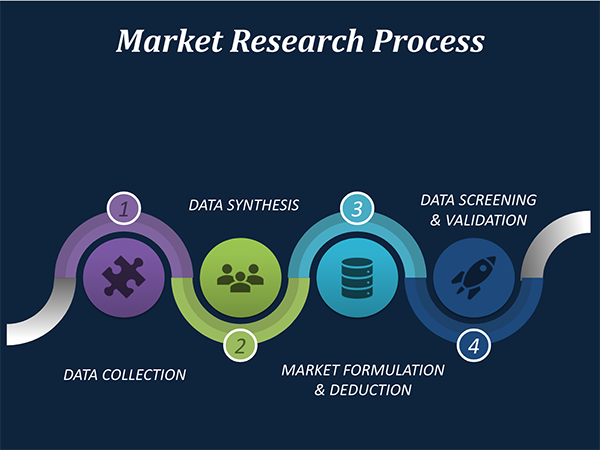
Data Collection: This stage of the market research process involves with the gathering and collecting of the market/industry related data from the sources. There are basically two types of research methods:
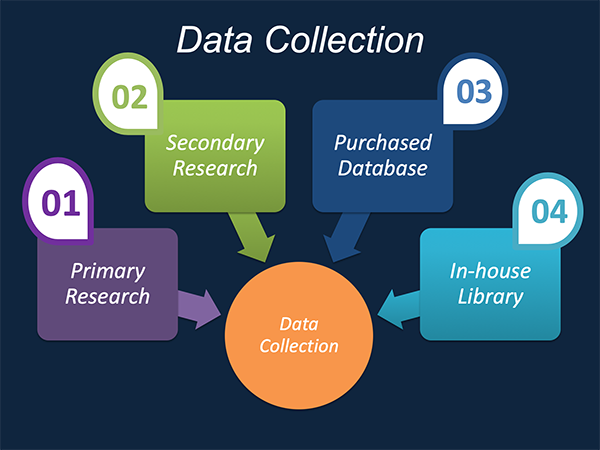
Data Synthesis: This stage includes the evaluation and assessment of all the data acquired from the primary and secondary research. It likewise includes in evaluating the information for any disparity watched while information gathering identified with the market. The data & information is gathered with consideration to the heterogeneity of sources. Scientific and statistical methods are implemented for synthesizing dissimilar information sets and provide the relevant data which is fundamental for formulating strategies. Our organization has broad involvement with information amalgamation where the information goes through different stages:
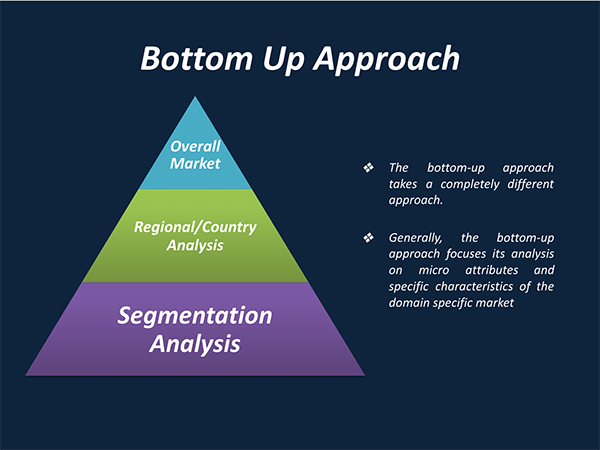
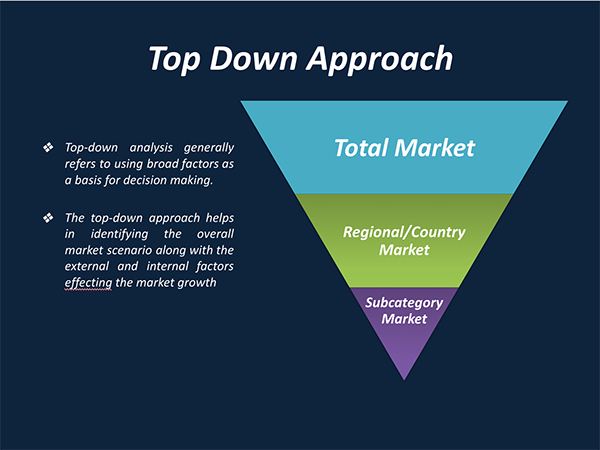
Market Formulation & Deduction: The last stage includes assigning the data & information in a suitable way in order to derive market size. Analyst reviews and domain based opinions based on holistic approach of market estimation combined with industry investigation additionally features a crucial role in this stage.
This stage includes with the finalization of the market size and numbers that we have gathered from primary and secondary research. With the data & information addition, we ensure that there is no gap in the market information. Market trend analysis is finished by our analysts by utilizing data extrapolation procedures, which give the most ideal figures to the market.
Data Validation: Validation is the most crucial step in the process. Validation & re-validation through scientifically designed technique and process that helps us finalize data-points to be used for final calculations. This stage also involves with the data triangulation process. Data triangulation generally implicates the cross validation and matching the data which has been collected from primary and secondary research methods.
Free Customization
Countries can be added on demand
Free yearly update on purchase of Multi/Corporate User License
Companies served till date

We serve our customers 24x7 for 365 days through calls, emails and live chat options.
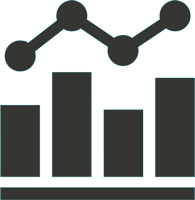
Huge database of exceptional market reports bringing market intelligence to your fingertips.

SSL enabled, we offer you various secured payment options for risk free purchase.